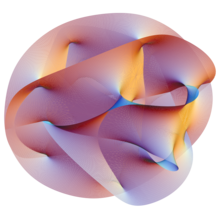玻色弦理論
玻色弦理論(英語:Bosonic string theory)是最早的弦論版本,約在1960年代晚期發展。其名稱由來是因為粒子譜中僅含有玻色子。
1980年代,在弦論的範疇下發現了超對稱;一個稱作超弦理論(超對稱弦理論)的新版本弦論成為了研究主題。儘管如此,玻色弦理論仍然是了解微擾弦理論的有用工具,並且超弦理論中的一些理論困難之處在玻色弦理論中已然現身。
疑難
[编辑]雖然玻色弦理論有許多吸引人的特質,其在成為物理模型理論有兩大缺陷:
類型
[编辑]有四種可能的玻色子弦理論,取決於是否允許開弦以及弦是否具有指定的可定向性。四種可能理論的光譜示意圖如下:
| 玻色弦理论 | 非正狀態 |
|---|---|
| 可開弦定向 | 快子、引力子、脹子、無質量反對稱張量(massless antisymmetric tensor) |
| 可開弦無向 | 快子、引力子、脹子 |
| 閉弦定向 | 快子、引力子、脹子、反對稱張量(antisymmetric tensor)、U(1)、矢量玻色子 |
| 閉弦無向 | 快子、引力子、脹子 |
請注意,所有四種理論都有一個負能量快子 () 和一個無質量引力子。
數學表示
[编辑]路徑積分表述
[编辑]is the field on the worldsheet describing the embedding of the string in 25+1 spacetime; in the Polyakov formulation, is not to be understood as the induced metric from the embedding, but as an independent dynamical field. is the metric on the target spacetime, which is usually taken to be the Minkowski metric in the perturbative theory. Under a Wick rotation, this is brought to a Euclidean metric . M is the worldsheet as a topological manifold parametrized by the coordinates. is the string tension and related to the Regge slope as .
has diffeomorphism and Weyl invariance. Weyl symmetry is broken upon quantization (Conformal anomaly) and therefore this action has to be supplemented with a counterterm, along with a hypothetical purely topological term, proportional to the Euler characteristic:
The explicit breaking of Weyl invariance by the counterterm can be cancelled away in the critical dimension 26.
Physical quantities are then constructed from the (Euclidean) partition function and N-point function:

The discrete sum is a sum over possible topologies, which for euclidean bosonic orientable closed strings are compact orientable Riemannian surfaces and are thus identified by a genus . A normalization factor is introduced to compensate overcounting from symmetries. While the computation of the partition function corresponds to the cosmological constant, the N-point function, including vertex operators, describes the scattering amplitude of strings.
The symmetry group of the action actually reduces drastically the integration space to a finite dimensional manifold. The path-integral in the partition function is a priori a sum over possible Riemannian structures; however, quotienting with respect to Weyl transformations allows us to only consider conformal structures, that is, equivalence classes of metrics under the identifications of metrics related by
Since the world-sheet is two dimensional, there is a 1-1 correspondence between conformal structures and complex structures. One still has to quotient away diffeomorphisms. This leaves us with an integration over the space of all possible complex structures modulo diffeomorphisms, which is simply the moduli space of the given topological surface, and is in fact a finite-dimensional complex manifold. The fundamental problem of perturbative bosonic strings therefore becomes the parametrization of Moduli space, which is non-trivial for genus .
h = 0
[编辑]At tree-level, corresponding to genus 0, the cosmological constant vanishes: .
The four-point function for the scattering of four tachyons is the Shapiro-Virasoro amplitude:
Where is the total momentum and , , are the Mandelstam variables.
h = 1
[编辑]
is a complex number with positive imaginary part ; , holomorphic to the moduli space of the torus, is any fundamental domain for the modular group acting on the upper half-plane, for example . is the Dedekind eta function. The integrand is of course invariant under the modular group: the measure is simply the Poincaré metric which has PSL(2,R) as isometry group; the rest of the integrand is also invariant by virtue of and the fact that is a modular form of weight 1/2.
This integral diverges. This is due to the presence of the tachyon and is related to the instability of the perturbative vacuum.
相關條目
[编辑]參考
[编辑]- ^ D'Hoker, Phong
參考文獻
[编辑]D'Hoker, Eric & Phong, D. H. The geometry of string perturbation theory. Rev. Mod. Phys. (American Physical Society). Oct 1988, 60 (4): 917–1065. Bibcode:1988RvMP...60..917D. doi:10.1103/RevModPhys.60.917.
Belavin, A.A. & Knizhnik, V.G. Complex geometry and the theory of quantum strings. ZhETF. Feb 1986, 91 (2): 364–390 [2022-06-18]. Bibcode:1986ZhETF..91..364B. (原始内容存档于2021-02-26).



![{\displaystyle I_{0}[g,X]={\frac {T}{8\pi }}\int _{M}d^{2}\xi {\sqrt {g}}g^{mn}\partial _{m}x^{\mu }\partial _{n}x^{\nu }G_{\mu \nu }(x)}](https://wikimedia.org/api/rest_v1/media/math/render/svg/ec86e41babcae6c6ab47e0d5dd06f409a09f4df5)









![{\displaystyle Z=\sum _{h=0}^{\infty }\int {\frac {{\mathcal {D}}g_{mn}{\mathcal {D}}X^{\mu }}{\mathcal {N}}}\exp(-I[g,X])}](https://wikimedia.org/api/rest_v1/media/math/render/svg/408aee3735e2a27d069ca0a2dd646525769b0d0e)
![{\displaystyle \left\langle V_{i_{1}}(k_{1}^{\mu })\cdots V_{i_{p}}(k_{p}^{\mu })\right\rangle =\sum _{h=0}^{\infty }\int {\frac {{\mathcal {D}}g_{mn}{\mathcal {D}}X^{\mu }}{\mathcal {N}}}\exp(-I[g,X])V_{i_{1}}(k_{1}^{\mu })\cdots V_{i_{p}}(k_{p}^{\mu })}](https://wikimedia.org/api/rest_v1/media/math/render/svg/f3f4a8f6392cefd08b4a3e41e97b10207ece8003)




















